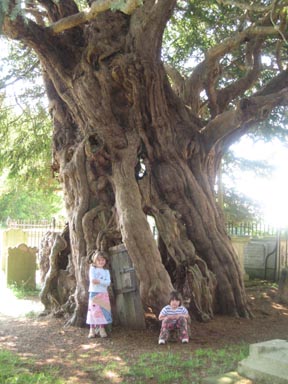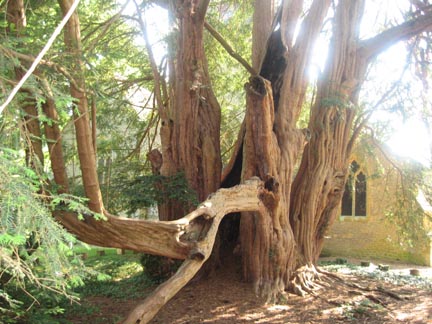Here’s looking at yew, kid
By Ruth D’Alessandro, The Wildlife Gardener After posting my water bill piece, I decided we ought to get out more. And so we did. To look at some very big trees. Surrey and Kent have some of the most magnificent ancient trees in the country. Two yews (Taxus baccata) in particular are just breathtaking: the Tandridge Yew in the churchyard of our own parish church, St Peter’s and just down the road, the Crowhurst Yew in the churchyard of St George’s, Crowhurst. Both are reckoned to be around 4000 years old. The sheer majesty and atmosphere of both these venerable trees go beyond description, so I’ll attempt no words here. See for yourselves:



Amazing facts you always wanted to know about yews, but were afraid to ask…
- Yew trees are traditional graveyard species. Because they are poisonous they were planted originally to deter farmers from allowing cattle to graze in the churchyards
- The only part of the yew that is not poisonous is the red aril (fleshy berry-like covering of the seed). This is so that the seeds can be eaten safely by birds and dispersed. These fruits were known in some parts of England as ‘snotty gogs’ or ‘snottle berries’.
- According to folklore, 99 yews may be planted in a churchyard (must be a big churchyard) but the 100th will always die
- Longbows were traditionally made of yew wood
- The cancer drug Paclitaxel is derived from the yew (also sold as Taxol or Abraxane, all derived from the scientific name for yew, Taxus sp.)
So how does this all fit in with the Wildlife Garden? Well, we have some holes in our mixed hedgerows of hawthorn, oak, maple, beech, hazel and holly, and we were wondering what to fill them with. What better, or more local, species to fill the gaps than some hedging yew? So we went off to a local nursery and bought three little yew bushes. If they do as well as the Tandridge and Crowhurst yews, the future occupants of the Wildlife Garden won’t have to worry about building a garden wall. Next post: Mixed Feelings ” When A Grass Snake Sets Up Home With Your Newts And Frogs
- Spurn Spawn! - 26th February, 2014
- Bluebells on wheels: axles of evil? - 2nd February, 2011
- Raising the ba: Wildlife and the Ancient Egyptian Book of the Dead - 8th January, 2011

Wow. I am blown away by the Tandridge Yew, firstly by its sheer size and age, but also by the fact that I can look at it and see something that would not have changed greatly since my great-great grandparents were married in the nearby church in 1846.
Did you know:
The yew has survived the great climatic changes of our planet-fossils date back more than 140m years. Many yews we see today are more thn 1,000 years old. It’s longevity attracts more folklore than any other tree.
The age of a yew can be determined by it’s trunk-it’s girth increases by a foot every 30 years. A yew whose trunk measures 25 feet will have stood since the first millennium.
There are seven species of yew. Taxus baccata is native to the UK and grows best on limestone and chalk soils . The beautiful dense, deep golden timber with it’s red core is easy to carve and was used to make wheels, cogs, axles, spoons, bowls and even the body of lute.
The vikings trusted hard-as-iron yew nails to hold ships together, and yew weapons can be found in museums across the country. The oldest wooden artifact found was a spear made of yew, 150,000 years old and buried in peat in Essex. A 90,000-year-old yew spear was found preserved in peat between an elephants ribs in Germany. But it was the yew’s unique combination of hard heart and springy outer wood that armed English archers with the famous longbow.
Hi Julian!
I have sent an email to you at Francis Frith. I hope I can be of assistance!
Hi Ruth, nice pic of the Crowhurst yew (with junior wildlife gardeners). I’d like to shortlist it for possible use in a book we’re publishing on ancient trees. Please get in touch!
Hi Ruth, we have just planted a yew hedge (to-be) along the edge of our wildlife corridor in the churchyard at St Mary’s in Bletchingley – we chose the ‘tree of life’ firstly because of it being known as a symbol of immortality and resurrection and therefore appropriate in the churchyard but also because it is protective both physically – larger examples protecting the church from the weather and in our smaller example providing another habitat for wildlife, and symbolically since in folk belief they are thought to give protection from evil. You don’t need many more reasons than that to persuade the congregation to sponsor one each and they did.
Thanks Rachel! Some friends who own an original Tudor hall house (zany beams or what!) have some fab mixed hedging including yew and it looks great, not at all formal. We took a 1ft yew seedling to London with us and it grew to 7ft high and 4ft wide (with judicious clipping) in 13 years. Our little yews are about 3 ft tall.
Absolutely stunning. I have always liked a yew hedge, but thought it more of a formal hedge.
We also have a mixed informal hedge with many gaps. We have been adding hawthorn holly and pyracantha (to stop the footpath dogwalkers alongside climbing through) but now I just can’t resist getting some yew – very inspiring!
There’s some debate about the pre-christian sites theory, too – some suggest that the age of yews is sometimes exaggerated to allow that hypothesis.
Hi Alan! Both churches at Tandridge and Crowhurst are ‘only’ 1000 and 800 years old, so the yew trees were large and well-established before they were built. The trees certainly have their own magic and atmospheres. It would make sense. If I find any evidence to support this, I’ll let you know.
I read some shamanism type say that it’s possible these ancient yews were pre-christian holy groves incorporated into christian religious structures (churchyards) to encourage conversion – a bit like how the spanish apparently built their Peruvian chapels on the knee high remains of Incan temples.
I wonder if there’s any evidence for that with the Yews?